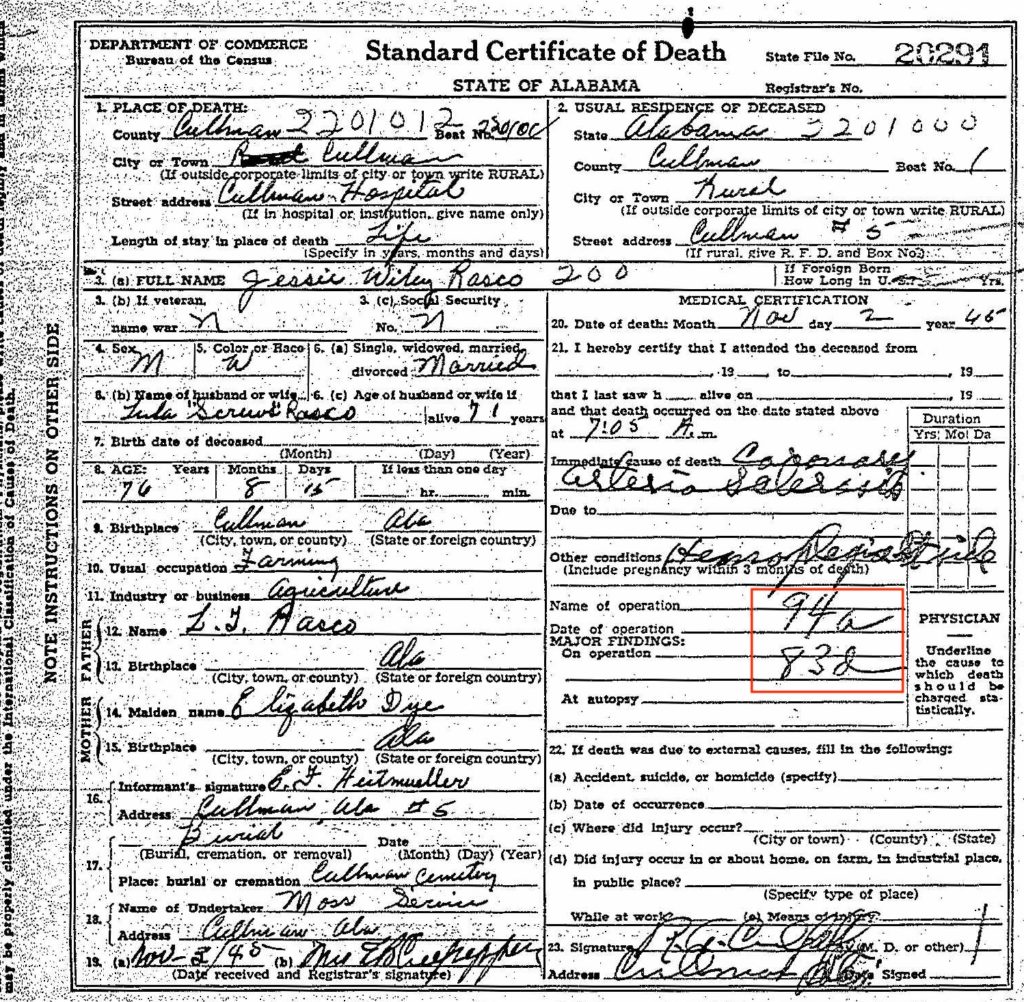Death certificates can provide such great information, which is why I always try to track them down. Often my eye makes a bee-line for the names of the parents of the deceased, but of course there’s much more information to be found. One area, cause of death, is always of interest. Unfortunately, that information seems to often be the most illegible. In the past, if I could make out the words I would add them to my database. But if I couldn’t, I’d just move along.
But I’ve learned that with a little more effort you can decipher the cause of death and learn more about your ancestor. Often, in addition to the written-out words describing cause of death, there’s a ICD (International Classification of Diseases) code as well. If you can’t read the words, you can look up the ICD code to get more information. Just visit the International Classification of Diseases page at Wolfbane.com to track down the meaning of the code.
Let’s use a death certificate from my great grandfather’s brother, Jesse Wiley Rasco (1978-1957), to illustrate this.
Here’s his 1945 death certificate. I’ve put a red border around the ICD codes.
As you can see, the ICD code for the primary cause of death is 94a. And the ICD code for the secondary cause of death is 83d. I could read the words for the primary cause of death. To me, it looks like Coronary Arteriosclerosis. Ordinarily, I would have stopped there. But the secondary cause of death was hard to decipher and I was curious.
I went to the International Classification of Disease page at Wolfbane.com and clicked on ILCD Revision 5 (1938), which would have been the version in use in 1945, since the next revision came out in 1948. The codes are listed in numerical order, so it was easy for me to find 94a, “diseases of the coronary arteries.” The secondary cause of death, 83d, is “hemiplegia and other paralyses of unstated origin.” Once I read that, I could see the word hemiplegia in the handwriting. It’s hard to make out the word after, but it looks to me like it could be “stroke.” I looked up the word hemiplegia and learned that it means “Paralysis on one side of the body.” [Edited to add: I received a note from reader Dennis Young suggesting that the handwriting says “Rt. side.” That makes complete sense and now seems obvious! The plot thickened a little when I received a note from reader Brad Pierce suggesting that the words say Lt. side, not Rt. side. Brad’s a physician himself so is probably good at deciphering doctor’s handwriting! I can’t tell whether it’s left or right, but I’m so glad to accept the “side” part. Thank you Dennis and Brad!]
Knowing that this 76-year-old farmer was living with paralysis on one side of his body at the time of his death gives me a bigger picture of what his life experience (or least the end of his life) was like.
As you can see, taking time to look up ICD codes when you see them might provide you with more information about your ancestor or might even solve a mystery. Just be sure you’re looking at the pertinent Revision!


Janine
Good to know. Also, Death Certificates are key proofs in DAR and SAR for proving parents names
Jerry
Thanks, Jerry. Good to know!
Awesome info, Janine. Many thanks!
You’re welcome, Christy!
Great info about the ICDA codes. Rasco’s secondary cause of death is hemiplegia (left/right) side. It is hard to figure out which side though. We are trying to obtain a 1982 death certificate from upstate New York. Without the actual county location for death, it’s becoming expensive to rule each county out in the area.
At one stage in my life, I used the ICD book quite frequently. One cause that was rarely used was the one for “senility”. The original usage of that word meant “old age”, not as we tend to use it now as a term to mean “senile dementia” which was another code entirely. If someone is a 100 yrs old, and they die in their sleep with no pre-existing conditions, surely they died of old age.
Thanks for that comment, John! I’ve noticed senility on some death certificates and, since I didn’t look up the code, I assumed it meant dementia. I appreciate that insight!
Where can you see Death Certificates for free or how can you see them?
Linda, Family Search has a lot of death certificates and Family Search is free. I view most the death certificates for my ancestors on Family Search and on Ancestry. (I have a subscription.) I got a few (that I paid for) from state archives as well. I’ve written a couple of blog posts about Family Search you might find helpful. (1) Using the card catalog to find elusive documents on Family Search (https://organizeyourfamilyhistory.com/using-card-catalog-find-elusive-documents-family-search/) and (2) Using Family Search to find images referenced on Ancestry (screencast) (https://organizeyourfamilyhistory.com/using-family-search-to-find-images-referenced-on-ancestry-screencast/).
Here in Missouri, death certificates from 1910-1969 are available free on the state archives’ website (https://s1.sos.mo.gov/records/archives/archivesmvc/deathcertificates). That may be true of other states as well.